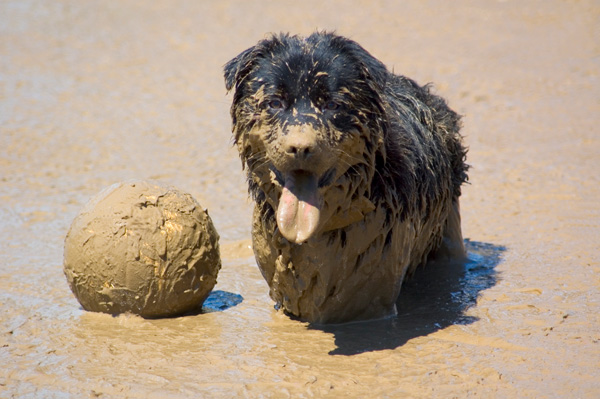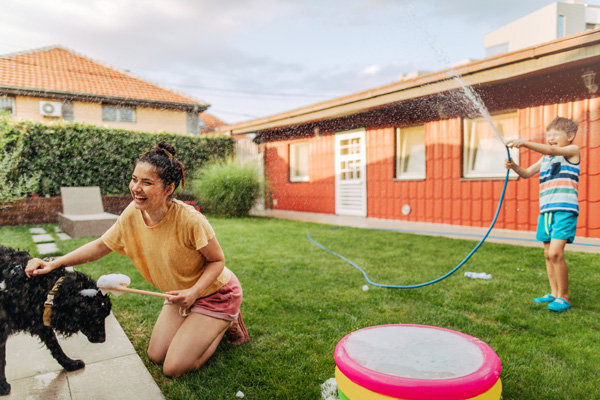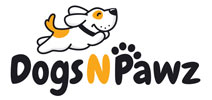Bath time. One of the most dreaded phrases in the English language. For dogs, anyway. And maybe kids.
Bath time can be stressful for dogs and owners, who end up just as wet as their pets, unless their dog is a very good boy or girl and doesn’t struggle. Even a dog who isn’t prone to being anxious in the tub is going to guilt their humans with those sad puppy dog eyes for the perceived betrayal. Shaking is inevitable. Wet walls and extra laundry will occur. For this reason, it’s tempting to avoid a dog bath. But your reward for your efforts and messy bathroom is a fresh, clean, fluffy dog to snuggle with.
When must you wash your dog?

Sometimes, an immediate bath is necessary for obvious reasons:
- Your dog decided to take a mud bath
- It rolled around in something stinky
- It ate something messy or had an accident
- He or she feels greasy to the touch
- Extreme itching (some shampoos reduce itch)
- Your dog is severely shedding (a bath and grooming can speed this along)
- The doggie smell has become overwhelming and follows, or precedes, your dog
- Your dog jumped in a body of water that may be contaminated or itch inducing
- Skunk encounter
- Fleas
Anything can happen outside of your regularly scheduled bath time.
What if your dog doesn’t need an emergency bath?
As for the rest of the time? It depends on the dog. A dog’s coat contains natural oils that keep it looking healthy and overwashing can lead to dry skin or other skin conditions. If your dog is feeling extra oily, it’s probably time for a bath. But if your dog is flaking, which some short haired dogs like Dachshunds are prone to do in the hot summer months, you may want to hold off on giving them a dip. Your vet, groomer, breeder, animal rescue facility or dog trainer may be able to share some general guidance on options for your specific breed.
According to the American Kennel Club, some hairless breeds like a Chinese Crested need weekly baths, but a Puli doesn’t need to be bathed often once it’s corded. Labs, Retrievers, Huskies and other thick or double coated dogs are prone to having their natural oils reduced by overbathing.
Double coated dogs with thick fur require more work and effort to clean and dry. Shorter haired dogs are faster to wash and also don’t trap as much dirt in their coats. Indoor dogs stay cleaner longer than outdoor dogs. Pre-existing skin conditions may require more, or less washing.
Dogs also groom themselves, albeit not quite like a cat.
On average, dogs can be bathed every two weeks. It’s a good starting place if you’re a new dog owner. Evaluate the dog’s response to the bath. Does their coat return to its normal lustre and gloss? Does the dog’s skin seem healthy, or is it too dry? Guess and test what’s right for your specific dog — all dogs are different. If your dog does well with a bath every two weeks, you can extend the period between washings and continue to observe. Your dog may do best with a bath every month, or need fewer baths in the summer, or need an extra one during shedding season.
A bath is a great time to pay attention to your dog’s overall health and check for fleas, ticks, growths or other skin conditions you may miss when your dog is its normal fluffy self. This goes for indoor and outdoor dogs.
The product you use is just as important as the frequency, and may impact how often your dog needs a scrub. Sharing shampoo with your furry friend isn’t recommended. Human shampoo isn’t formulated for dogs. Dogs have a different PH than humans and overly acidic or alkaline shampoos can inflame a dog’s skin. Pet stores carry a range of shampoos and conditioners just for dogs.
The right shampoo can help with itching, flea prevention, and dry skin. Vets are able to recommend a specific medicated shampoo for skin conditions and topical flea prevention.
You can also make your own dog shampoo using castile soap combined with essential oils like rosemary or lavender. Other home made options include mixing vinegars with non toxic soaps and aloe (for those itchy dogs). Apple cider vinegar can be used to relieve itchy and flakey skin (and manage yeast growth), as long as it’s diluted half and half with water and you don’t get it in any cuts or sores on your dog’s paw pads or body. It may also help repel fleas, but won’t kill them.
Oatmeal is another popular ingredient in homemade shampoo. If you go the homemade route, you may need to try a few different recipes before you find one that makes your dog’s fur and skin the happiest.
No matter what you’re using, dogs need to be well rinsed after a bath. Make sure the water is running clear off your dog and that all remnants of shampoo are gone.
Make baths easier on everyone
Train your dog to like baths while still a puppy
Puppies need to be desensitized to a lot of things to make their owners lives easier in later years. Getting a pup used to being in the bathtub — how their feet feel on the tub or bath mat, the sound of water running, the showerhead, the bathroom echo — can save a lot of frustration down the road. Make it fun by putting some favourite toys in the tub and offer treats even if your pup doesn’t seem overly bothered by the experience. Positive associations are key in any step of training, bath time included.
Peanut butter the edges of the tub
No joke. Spread some peanut butter on the inside edges of the tub. It may distract your dog enough to lather and rinse. At the very least, it will create positive associations with the bath, which is critical to cut down on anxiety and stress. Your dog doesn’t like peanut butter? Try another dog safe nut butter or a spreadable product you know your dog does enjoy, like a soft cheese.
Prefill the tub with water
If your dog startles at loud noises or is skeptical of the bath, run a few inches of water into the tub before your pet gets in, so that you don’t have to deal with anxiety from the loud sound of water running.
Detangle your dog’s coat before getting it wet
Long haired dogs are easier to wash after combing, because you can remove any snarls or tangles before they get wet or mat further. Brushing first can speed up the time spent in the bath working on knots.
Try a dog wash station at a pet store
If you’re loath to get your bathroom soaking wet and or to do the clean up that comes after a bath, some pet stores offer dog wash stations. A commercial dog wash usually includes shampoo, treats, towels, dryers (and an apron for you!) in the cost. Your home bathroom won’t smell like a wet dog. Dogs with social anxiety may be resistant to having a bath in an unfamiliar place, so this option might be better for easy going dogs.
Take bath time outside

If you’re worried about your bathroom, try washing your dog in a kiddie pool outside or with the hose. The downside to the hose is that the water is likely cold, so have a couple buckets of lukewarm water ready for rinsing if your dog hates cold water, or it’s cool outside. Your dog may enjoy a cooler bath during the summer if he or she has a thick coat and is feeling the heat.
Four hands are better than two
Persuade a friend or family member to help at bath time. Four hands make the process faster for bath resistant dogs, and one person can feed treats while the other washes. A pair of extra hands can help keep your dog in the tub, rather than having it jump out and make a break for it for the comfy couch — soaking wet.
Enlist a groomer
If bath time is an entirely unwanted chore, find a reputable groomer in your neighborhood. Many groomers offer services beyond a bath and blowdry, including fur and nail trimming, and ear cleaning.

